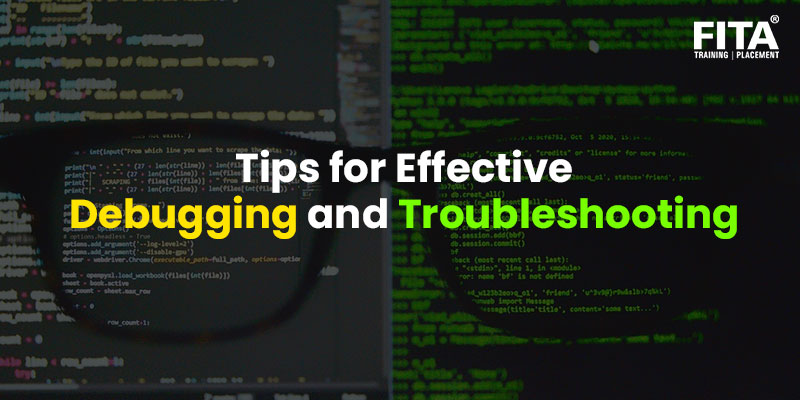
Debugging and troubleshooting are important skills for software developers and engineers. These skills involve identifying and resolving issues, bugs, and errors in software applications. Effective debugging not only resolves immediate problems but also improves code quality and enhances the development process. In this technical blog, we will explore valuable tips and techniques for effective debugging and troubleshooting, complete with practical examples and functions.
Understanding the Bug
Before delving into debugging, it is essential to gain a clear understanding of the bug or issue at hand. Reproduce the problem consistently and gather as much information as possible, such as error messages, logs, and user reports. Analyse the symptoms, comprehend the expected behaviour, and determine any patterns or factors that may be the cause of problems. This understanding will guide your debugging efforts and help you narrow down potential causes.
Divide and Conquer
When dealing with complex bugs, attempting to tackle the entire codebase at once can be overwhelming. Instead, divide the issue into smaller components and centralise the focus on just one thing at a time. Isolate the code section where the issue is likely to reside and apply systematic debugging techniques to narrow down the root cause. By employing the divide and conquer approach, you can effectively identify the problematic code or component.
Enrol in the iOS Training in Chennai to learn more about iOS and applications, and become familiar with iOS development.
Using Debugging Tools
Modern programming languages and development environments provide powerful debugging tools that significantly assist in troubleshooting. Familiarise yourself with the debugging features of your chosen language or framework, such as breakpoints, step-by-step execution, and variable inspection. Utilise these tools to observe the program’s state, track variable values, and identify the point of failure. For interactive debugging, you can use the pdb module in Python,
import pdb
def some_function():
pdb.set_trace()
# ...
variable = calculate_something()
print(variable)
Types of Debugging Tools
Integrated Development Environment (IDE) Debuggers
IDEs often come with built-in debuggers that provide a comprehensive set of debugging features. These tools allow software developers to set breakpoints, step through the code, inspect variables, and observe the program’s state during execution. IDE debuggers offer a user-friendly interface and integrate seamlessly with the development environment. Popular IDEs such as Visual Studio, Eclipse, and PyCharm provide powerful debugging capabilities.
Command-Line Debuggers
Command-line debuggers are standalone tools that allow developers to debug applications from the terminal or command prompt. These tools provide similar functionalities to IDE debuggers but without the graphical interface. Command-line debuggers are especially useful in scenarios where using an IDE is not feasible or preferred. Examples of command-line debuggers include GDB (GNU Debugger) for C/C++ programs and pdb (Python Debugger) for Python programs.
Profilers
Profilers help identify performance bottlenecks and optimise code execution. They collect information about a program’s resource usage, such as CPU time, memory usage, and function call frequency. Profilers provide detailed reports and visualisations that help pinpoint areas of code that require optimisation. Popular profiles include the Python Profiler, Java VisualVM, and Xcode Instruments for iOS development.
Log Analysis Tools
Log analysis tools help analyse and interpret log files generated by applications. These tools enable developers to search, filter, and correlate log messages to understand the sequence of events leading up to a bug or error. Log analysis tools can automatically identify patterns or anomalies in log data, making it easier to pinpoint the cause of an issue. Examples of log analysis tools include ELK Stack (Elasticsearch, Logstash, Kibana) and Splunk.
To learn more about the complexities of iOS and the creation of applications, Join the iOS Training in Bangalore.
Log and Print Statements
Logging and print statements are essential tools for understanding high level programming language execution flow and identifying potential issues. Strategically place log statements throughout your code to capture relevant information, such as variable values, function calls, and control flow. Leverage logging frameworks or write custom logging functions to control the verbosity and flexibility of your logs. Print statements are also useful for quickly checking the values of variables at specific points in the code.
import logging
logging.basicConfig(level=logging.DEBUG)
logger = logging.getLogger(__name__)
def some_function():
logger.debug("Inside some_function")
# ...
logger.debug("Variable value: %s", variable)
Reproduce the Bug
To effectively debug an issue, it is important to have a reliable way to reproduce it consistently. Create a minimal, standalone program or a test case that demonstrates the problem. This reduces complexity and helps you focus solely on the issue at hand. Isolate the specific inputs, steps, or conditions that trigger the bug and use them to verify and validate any fixes or changes.
Gather Information
Learn everything you can about the bug. This contains any user comments or feedback on the problem, as well as error messages, stack traces, and logs. It will be simpler to comprehend the bug and how it impacts the software application if you have more information. The most used programming language in debugging is Python
Learn more about the complexities of Python and how to construct applications by enrolling in Python Training in Chennai.
Analyse Symptoms
Carefully analyse the symptoms of the bug. What are the unexpected behaviours or outcomes? What parts of the application are affected? Understanding the symptoms helps narrow down the potential causes and focus your debugging efforts.
Comprehend Expected Behavior
Have a clear understanding of the expected behaviour of the software application. This involves reviewing the functional requirements, specifications, or user expectations. By comparing the expected behaviour with the observed symptoms, you can identify the deviations and pinpoint the areas that require investigation.
Version Control for Debugging
Version control systems like Git can be invaluable for debugging purposes. Use branches to isolate and experiment with potential fixes without affecting the main codebase. Commit your changes as you progress, allowing you to easily revert or review your debugging efforts. Git’s diff functionality can also help identify the specific code changes that introduced or resolved an issue.
Collaborate and Seek Help
When resolving challenging bugs, don’t be reluctant to ask your peers or the larger development community for assistance. Engage in pair programming sessions, where another developer can provide fresh insights and a different perspective. Online forums, chat groups, and platforms like Stack Overflow can also be valuable resources for seeking assistance or finding similar bug reports and solutions.
Test and Validate Fixes
After identifying and applying a fix, it is crucial to test and validate its effectiveness. Write test cases that cover the specific scenario or bug you encountered. Automated tests, such as unit tests and integration tests, provide a safety net to catch regressions and ensure that the issue is fully resolved. Regularly run your test suite to validate the stability and correctness of your fixes.
Learn more about Python’s complexities and the development of Python by enrolling in the Python Training in Salem.
Learn from Debugging Experiences
Every debugging session provides an opportunity for learning and growth. Take notes on the bugs you encounter, the steps you follow, and the techniques that proved effective. Maintain a personal debugging toolkit that includes code snippets, functions, and strategies that you can refer back to in future troubleshooting scenarios. By reflecting on your experiences and continuously improving your debugging skills, you become a more efficient and effective developer.
Conclusion
Effective debugging and troubleshooting are vital skills for software developers. You can improve your ability to locate and fix problems in your codebase by using the advice and methods below. Understanding the bug, using appropriate tools, logging strategically, and collaborating with others are key components of successful debugging also usage of scripting language. Remember to break down problems, reproduce bugs consistently, and thoroughly test and validate your fixes and also understand the list of programming languages. Continuously refine your debugging skills and leverage version control and community support to become a proficient troubleshooter. With practice and experience, you will become adept at tackling complex bugs and delivering robust and reliable software.


